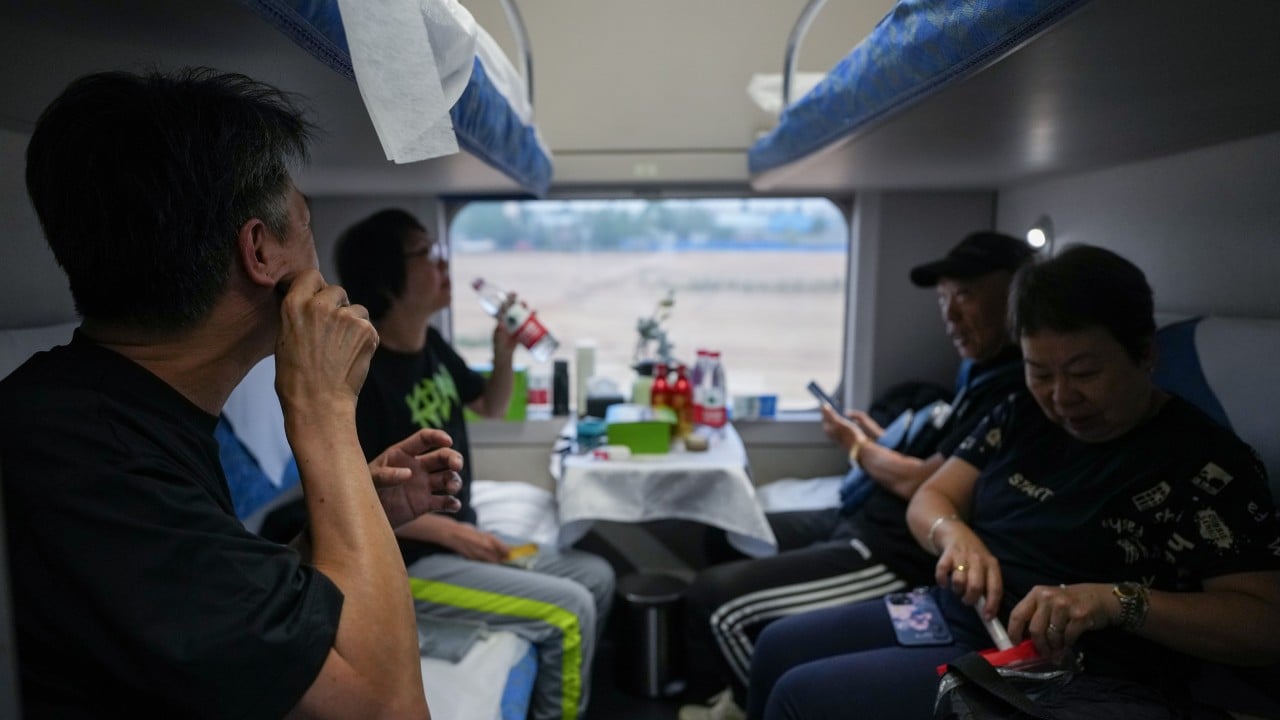The first high-speed sleeper trains from Hong Kong to Beijing and Shanghai arrived at their destinations on Sunday morning after journeys lasting about 12 hours.
Reporters from the Post were on board for the maiden trips to share their observations and all you need to know about essential amenities and other features.
Internet connection
Wi-fi was not available on board, with passengers and journalists relying on SIM cards to connect to the internet, which could be frustrating due to unstable connections.
“Trains in Japan and Taiwan provide free Wi-fi to passengers. I am really baffled that the train lacks this basic necessity,” said Wilson Cheung, 49, a security guard who took the Beijing-bound train.
Those who wanted to connect for work purposes or stream content to keep themselves entertained during the 12-hour trip might wish to bring along portable routers or reliable SIM cards with data.
Pre-downloading television shows or films was another solution for travellers who planned ahead.
Power charging
Only one power point, with two sockets, was available in cabins with two bunk beds. The outlet was located next to one of the lower berths, making it difficult for some passengers, especially those on the top beds, to charge their devices.
Ivy Ko, 43, who works in the public affairs industry, was one such unlucky traveller.
“It is extremely inconvenient for me to charge the phone as I slept on the other side of the cabin [to where the power outlet is located],” said Ko, who was in a top berth on the Shanghai-bound train.
Passengers might opt to use the three power points in the corridor of each carriage, but this means having to keep an eye on gadgets while they charge.
But even if passengers could secure the outlet in the cabin, some found the plug-and-socket connection to be unstable.
“I have sleep apnoea so I have my ventilator. But the power sometimes goes off all of a sudden for about five seconds [when charging],” said Rick Wong Wai-ki, 48, who works in the food packaging industry.
Some journalists brought along extension boards to charge multiple items including camera batteries and wireless microphones simultaneously.
Packing longer USB cables might help with charging problems. Passengers also needed adaptors as the sockets were those used on the mainland instead of Hong Kong.

Toilet facilities
On the Hong Kong to Beijing service, each carriage had 10 cabins with two bunk beds for four passengers. Up to 40 people have to share the bathroom facilities located at both ends of the carriage.
The area consisted of two toilets, one in a Western-style and the other a squat toilet. Two sinks were located outside.
The facilities became busy when passengers rushed to complete their evening routines before going to bed.
But the water pressure from the tap was weaker than expected, taking some time to wet a towel completely.
Travellers might consider taking a shower at home before boarding, or packing some handy body wipes to save time.
The situation was similar on the Shanghai-bound train, where passengers needed to wait for about 15 minutes for the toilets during busy periods.
The weak water pressure also added to the wait as passengers took longer to wash their hands.
But early risers were able to beat some of the morning queues for toilets.
An announcement let passengers know when the train was an hour from arriving at the destination, with staff also knocking on cabin doors about 45 minutes later.
While some southbound passengers told the Post they were supplied with toiletries, the northbound trains only provided slippers. A spokesman from the MTR Corporation later told the Post the supplies were decided by China Railway, which operates the services, based on different train models and situations.
Safety and privacy
The only available space for luggage was underneath the lower berths.
Cabin doors could not be locked from the outside, with many passengers having to take their valuables with them when they went to the toilet or dining car.
The bunk beds were not fitted with privacy curtains, which could make some feel uncomfortable when travelling with strangers.
Unlike the Beijing-bound train where all cabins were fitted with two bunk beds, the Shanghai-bound service also offered premium rooms with only one bunk and a sofa.
Meals
The dining compartment on the train to Beijing offered a number of meal options ranging from an affordable spicy chicken dish at a cost of 15 yuan (US$2) to stir-fried beef with king oyster mushroom or fried shrimps at 68 yuan.
A crispy pork dish at 30 yuan was a popular choice with eggplant and steamed vegetables as side dishes.
Apart from main courses, the train also had an array of beverages and snacks such as potato chips, chicken feet and sausages.
Meanwhile, on the train to Shanghai, fruit such as grapes and apples were available to purchase, with staff washing them for customers.
A variety of choices were available for meal boxes at prices between 15 and 80 yuan. Most were Chinese cuisine options.
Government response
Transport chief Lam Sai-hung, who was on board the train to Beijing, said he heard the concerns over insufficient charging and toilet facilities.
But some of the arrangements were beneficial, he said.
“For example, on planes, the washing facilities are placed inside the lavatories, while on sleeper trains, they are placed outside. This arrangement is actually well thought out,” Lam said on Sunday.
“By keeping washing facilities separate from the toilets, more passengers can be accommodated, providing considerate service.”
He added his bureau would also relay all the concerns to the MTR Corp and China Railway.


